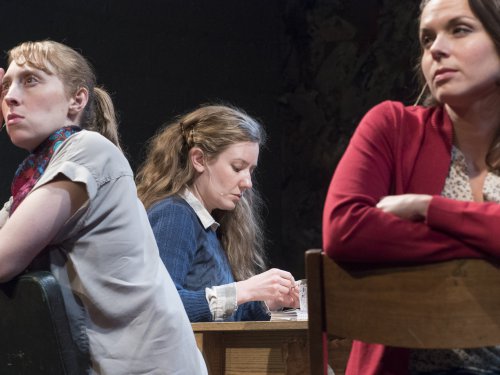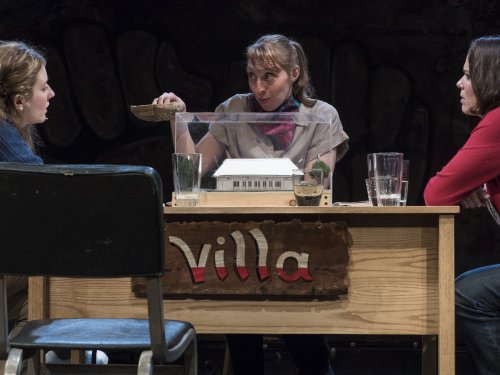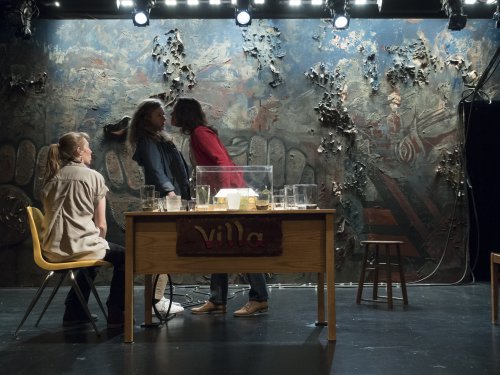Villa
Three women, all with the same name, debate a political issue in this absurd, tantalizing and chilling allegory. The complex performances are marvelous.

Crystal Finn, Harmony Stempel and Vivia Font in a scene from Guillermo Calderón’s “Villa” (Photo credit: Pavel Antonov)
[avatar user=”Darryl Reilly” size=”96″ align=”left” ] Darryl Reilly, Critic[/avatar]Absurd, tantalizing and chilling, Villa is in the genre of a political allegory set in an unnamed South American country. Here, with clues it is Chile. It’s in the darkly comic style of Wallace Shawn, Yasmina Reza, and with dashes of Harold Pinter’s One for The Road.
The three vibrant actresses in it, Crystal Finn, Vivia Font and Harmony Stempel are a dynamic team who mine all of the comedy and dramatic depth of their characters with commanding flair. Each is so individual, and it’s delightful observing them alternating between ferociously interacting with each other to being reflective.
Chilean playwright Guillermo Calderón constructs a simple, engrossing and often funny scenario. Three women, all named Alejandra, have been selected as members of a deliberative, special committee from a larger body who could not reach a decision over a searing national issue. There’s suspense, shocking revelations and Survivor-like machinations.

Harmony Stempel, Crystal Finn and Vivia Font in a scene from Guillermo Calderón’s “Villa” (Photo credit: Pavel Antonov)
That question is, “What to do with The Villa that has been destroyed? Should it be rebuilt as it was, or should it be redone as a museum? Gradually we learn that it was a detention center where women were tortured, raped and murdered.
Mr. Calderón’s script was translated into English by William Gregory, and is deliriously filled with integral references to the political situation in South America. Marxists, Leninists, Leftists, Communists, Brown shirts, Cuba, and Swedish and Dutch interventionists are all flavorfully bandied about. Various atrocities are described as well.
Calderón also directed and his staging is slyly subtle. At first, there’s the jarring setup of the women talking at a table with their backs to the audience. Soon, it’s just basic chatting. Eventually there’s more movement as conflicts arise. There’s even a magical realism sequence. The lighting design evolves from starkly realistic to strikingly fantastical. Calderón’s visual tone perfectly complements his offbeat script.

Crystal Finn, Harmony Stempel and Vivia Font in a scene from Guillermo Calderón’s “Villa” (Photo credit: Pavel Antonov)
María Fernanda Videla Urra’s physical production is an arresting combination of the simple and the profound. The eye-catching backdrop is a crumbling, graffiti-style covered wall with large, clenched fists. The rest is an assortment of vintage chairs and a basic table, with a sign hanging in front of it that says “The Villa.” On it, in the center, in a clear plastic display case is a small-scale model of The Villa. It all evocatively frames and surrounds the cast.
Mark Van Hare’s sound design is sparing, but is ominous in its small doses.
Villa, with its serious concerns vividly proves true the adage that comedy is tragedy plus time.
Villa (through April 1, 2017)
The Play Company
The Wild Project, 195 East 3rd Street, in Manhattan
For tickets, call 866-811-4111 or visit http://www.thewildproject.com
Running time: 90 minutes with no intermission






Leave a comment